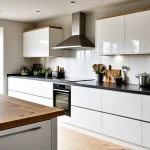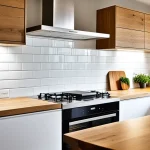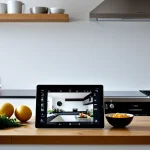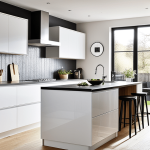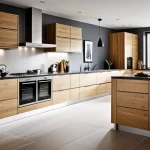Actionable Interior Decor Strategies for UK Restaurants
Small, targeted changes in restaurant interior decor can dramatically enhance the UK dining experience. Begin by aligning decor choices with your brand identity to create a cohesive atmosphere that reflects your restaurant’s personality. For example, a modern bistro might use sleek furniture and minimalist art, while a traditional British pub could embrace vintage accents and warm tones. This alignment strengthens customer recognition and loyalty.
Prioritising customer comfort and spatial flow is essential. Efficient layouts encourage natural movement and reduce congestion, improving guest satisfaction. Use ergonomic seating to ensure diners are comfortable during their meal, and arrange tables to balance intimacy with accessibility.
Also to read : How do UK restaurant bars attract and retain loyal customers?
Some actionable tips include:
- Introducing statement pieces like distinctive lighting or art installations that evoke your brand’s story.
- Opting for versatile furniture which can adapt to different group sizes, maximising space without compromising comfort.
- Incorporating tactile textures and colours that support the overall mood and theme.
By focusing on these practical steps, restaurants can effectively elevate their interiors, positively influencing the perception of service and food quality throughout the guest experience.
Also to see : How do UK kitchen restaurant bars train staff for exceptional service?
Actionable Interior Decor Strategies for UK Restaurants
Small, impactful decor changes can significantly improve the UK dining experience by creating an inviting and cohesive environment. Start by ensuring your restaurant interior decor aligns with your brand identity—this consistency helps guests connect emotionally and sets clear expectations.
Prioritising customer comfort and spatial flow is crucial. Effective layouts reduce congestion, allowing diners to feel at ease and staff to serve efficiently. Consider ergonomic seating that promotes longer, more enjoyable visits. Proper spacing between tables balances intimate conversations and privacy without sacrificing accessibility.
Some actionable tips to implement include:
- Introducing rich textures and colour palettes that reflect your brand’s personality.
- Using statement lighting to enhance atmosphere and draw attention to key areas.
- Selecting versatile furniture that adapts to group sizes and maximises available space.
Adopting these strategies ensures your restaurant interior decor not only looks appealing but also enhances guest satisfaction, directly impacting their overall experience and perception of service quality.
Actionable Interior Decor Strategies for UK Restaurants
Small but purposeful adjustments in restaurant interior decor can lead to significant improvements in the UK dining experience. Firstly, always align your decor with your brand identity. This ensures every element—whether wall finishes, furniture style, or colour choices—works harmoniously to tell your restaurant’s story. For instance, a seafood restaurant might incorporate nautical colours and textures that subtly evoke the sea, enhancing the theme and customer connection.
Prioritising customer comfort and spatial flow goes beyond aesthetics. Well-thought-out layouts allow diners to move freely and staff to serve efficiently. Consider ergonomic seating that supports long, relaxed meals without discomfort. Also, balancing table arrangements avoids overcrowding while maintaining an intimate atmosphere. These design choices foster a welcoming environment that encourages longer stays and repeat visits.
Some actionable tips include:
- Using flexible seating options that adapt to various group sizes, maximising versatility without compromising style.
- Incorporating rich textures that heighten sensory engagement, strengthening the overall ambience.
- Adjusting lighting and decor elements seasonally to keep the experience fresh and inviting.
By focusing on these targeted strategies, restaurants can elevate the dining experience and reinforce positive customer perceptions through effective restaurant interior decor.
Actionable Interior Decor Strategies for UK Restaurants
Small yet purposeful adjustments in restaurant interior decor can profoundly influence the UK dining experience. One of the most effective approaches is implementing targeted, impactful changes rather than large-scale overhauls. For instance, refreshing wall colours or introducing distinctive art can instantly rejuvenate the ambiance without major expense.
Another key strategy is meticulously aligning every decor element with your brand identity. This means selecting furniture, colour palettes, and decorative accents that consistently communicate your restaurant’s story and values. Such coherence deepens guest engagement and boosts brand recall.
Prioritising customer comfort and spatial flow remains paramount. Designing layouts that foster easy movement reduces crowding and enhances the dining atmosphere. When diners enjoy ergonomic seating and intuitive table arrangements, they naturally stay longer and feel more relaxed.
Some actionable tips to adopt include:
-
Introducing modular furniture that adapts quickly for varying group sizes, maintaining space efficiency.
-
Using layered lighting schemes to create welcoming zones while supporting practical needs.
-
Choosing textures and colours that resonate emotionally with your target audience, reinforcing the overall theme.
By focusing on these precise measures within your restaurant interior decor, you set the stage for a superior UK dining experience that delights guests and encourages repeat visits.
Actionable Interior Decor Strategies for UK Restaurants
Crafting a distinctive restaurant interior decor that elevates the UK dining experience hinges on three key strategies: implementing small, impactful decor changes, aligning decor with your brand identity, and prioritising customer comfort alongside spatial flow.
Small, targeted updates—such as swapping artwork or refreshing soft furnishings—can transform ambience quickly and cost-effectively. These subtle yet strategic changes invigorate the space without requiring extensive renovation, making them practical actionable tips for busy restaurateurs.
Aligning interior decor with your brand identity is essential in forging emotional connections with diners. Every element—be it the choice of colour schemes, furniture styles, or decorative accessories—should consistently narrate your restaurant’s story. This cohesion enhances recognition, contributing positively to how guests perceive your establishment.
Furthermore, prioritising customer comfort and spatial flow ensures guests feel welcome and relaxed. Ergonomic seating paired with thoughtfully spaced tables accommodates social interaction while preventing overcrowding. This spatial efficiency also streamlines staff movement, improving service delivery.
By focusing on these precise, actionable tips, UK restaurants can create interiors that not only look inviting but directly contribute to a superior, memorable dining experience.
Actionable Interior Decor Strategies for UK Restaurants
Targeted, small yet impactful decor changes remain a cornerstone in elevating the UK dining experience. For example, refreshing textiles or updating art pieces can immediately alter the atmosphere with minimal disruption. These tweaks are cost-effective and allow restaurants to remain dynamic and responsive to trends or seasonality without large-scale renovations.
Aligning interior decor consistently with your brand identity is another crucial step. Each design choice—from furniture finishes to colour scheme—should echo your restaurant’s unique story. This congruence fosters a memorable environment and strengthens emotional connections with guests. Consider how a rustic, countryside eatery might integrate reclaimed wood accents that reinforce authenticity, contrasting with a sleek urban diner utilising metallic tones for a modern vibe.
Prioritising customer comfort and spatial flow optimises both guest satisfaction and operational efficiency. Ergonomic seating encourages longer visits, while well-planned table arrangements prevent overcrowding and support smooth staff movement. These spatial strategies subtly influence customer behaviour, resulting in positive reviews and repeat business.
Actionable tips include:
-
Incorporating modular furnishings adaptable to different group sizes without sacrificing design.
-
Layering lighting to balance atmosphere with functionality.
-
Employing colours and textures that resonate emotionally with your target audience.
These focused approaches ensure that restaurant interior decor actively enhances the overall UK dining experience.
Actionable Interior Decor Strategies for UK Restaurants
Enhancing restaurant interior decor to elevate the UK dining experience involves three strategic focal points: small, impactful decor changes; aligning decor with brand identity; and prioritising customer comfort alongside spatial flow. First, implementing small, targeted updates—like changing furniture finishes or introducing new textures—can transform the ambiance without extensive renovation. These changes are practical and cost-effective, fitting the dynamic nature of restaurant operations.
Aligning decor with your brand identity is essential in creating a coherent atmosphere that resonates with guests. This means every design element—colour palettes, furniture styles, and decorative accents—should consistently reflect your restaurant’s personality. Such cohesion builds emotional connections, enhances recognition, and supports marketing efforts.
Prioritising customer comfort and spatial flow ensures diners enjoy a relaxed, stress-free environment. Ergonomic seating is critical; it not only promotes longer stays but also embraces a wide range of customer needs. Thoughtful table arrangements avoid overcrowding, balance intimacy with accessibility, and facilitate efficient staff movement. By focusing on these actionable tips, restaurants can significantly improve the overall dining atmosphere and guest satisfaction, making the decor a strategic asset in their success.

